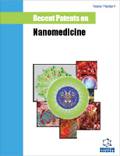Abstract
The main aim of this study was to design novel pentablock (PB) (PLA–PCL–PEG–PCL–PLA) polymer to prepare nanoparticles (NP) in order to achieve sustain delivery of pazopanib with minimal burst effect for the treatment of ocular neovascularization. Another purpose was to evaluate the effect of pazopanib loaded NP to bypass drug efflux with the discussion of recent patents. PB copolymer was successfully synthesized using ring opening polymerization reaction mechanism and characterized using 1H NMR, GPC and XRD analysis. Synthesized PB copolymer was found to noncytotoxic, non-immunogenic and biocompatible with ocular cell lines. Also, several parameters such as entrapment efficiency, drug loading, in vitro drug release profiling and effect of pazopanib NP in evading efflux transporters were examined. PB copolymer-based NP exhibited continuous release of pazopanib. It can be utilized to achieve continuous first order delivery of pazopanib upto 100 days from nanoparticles without any significant burst effect. Pazopanib loaded NP were successful in evading drug efflux mediated via efflux transporters. This formulation can be employed to circumvent ocular barriers without altering ocular protective mechanisms. Our results indicated that PB copolymer based drug delivery systems can serve as a platform technology for the development of sustained release therapy for the treatment of ocular neovascularization. This drug delivery system can also be applicable for other ocular complications.
Keywords: Efflux transporters, ocular drug delivery, polymeric nanoparticles, sustained release, tyrosine kinase inhibitors.
 33
33

